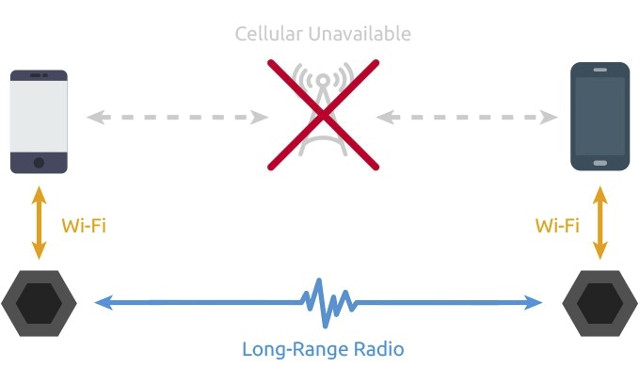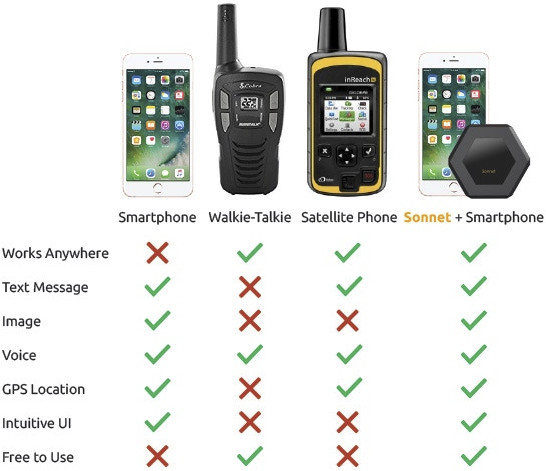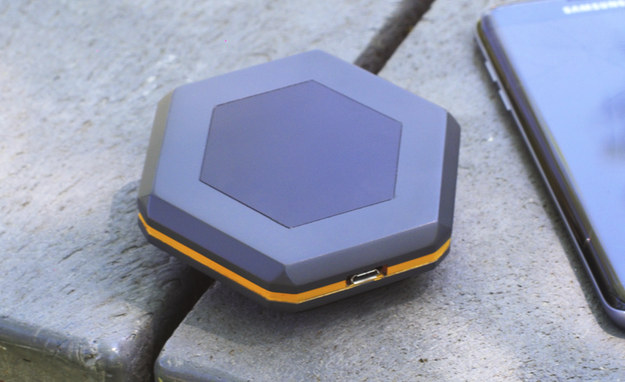Cellular networks are available in most places, but not always, and you may not have connectivity while climbing mountains or other remote locations, when going abroad, during natural disaster, in very crowded places where network capacity is exceeded, or when your government decides to cut it off for “national stability and harmony”. Wouldn’t it be great if you were still able to contact with your friend in such cases, and create your own mesh networks expanding over several kilometers? That’s exactly what Sonnet does by connecting to your smartphone over WiFi, and to other Sonnet nodes over ISM frequencies (433, 868 and 925 MHz).
Sonnet hardware specifications:
- Connectivity
- 802.11 b/g/n WiFi with up to 20 dBm (max varies per country); WPA/WPA2 security
- Long Range RF
- Frequencies
- 915 MHz (North America)
- 868 MHz (Europe)
- 433 MHz (Asia Pacific)
- Distance – 5km typ.; up to 10km Line-of-sight; SMA connector available to extend the range with your own antenna
- Transmit power – 1W (30 dBm)
- Receiver Sensitivity – -148 dBm
- Modulation Method – Chirp Spread Spectrum (CSS)
- Frequencies
- Power Supply – micro USB port. Input: 5V / 2A; Output (e.g. to charge phone): 5.1V @ 2.1 A
- Battery – 4,000 mAh LiPo battery good for up to 24 hours
- Dimensions – 88 x 80 x 17 mm
- Weight – 160 grams
- IP Rating – IP66 rating under IEC standard 60529
 Those are based on the same frequencies as LoRa, but since they don’t mention the standard at all, it must be a proprietary solution. The device should be legal in most countries, including North America, Europe, and China, but you’d still need to check, as it’s illegal in mine. I can use 433 MHz up to 10 mW only, and the 1W transmit power makes it illegal here.
Those are based on the same frequencies as LoRa, but since they don’t mention the standard at all, it must be a proprietary solution. The device should be legal in most countries, including North America, Europe, and China, but you’d still need to check, as it’s illegal in mine. I can use 433 MHz up to 10 mW only, and the 1W transmit power makes it illegal here.
The initial setup involves connecting to Sonnet access point, going to https://app.sonnetlabs.com from your web browser, and start using the app to communicate. You can chat, send pictures and voice recordings, and share your GPS coordinates. It’s like a high-end talkie walkie with higher range, and you can create a mesh network of those with up to 16 hops supported, corresponding to a 80 km range. An firmware update planned for 2018 will also allow Sonnet to create an Internet connected mesh network, with all your need is at least one Sonnet connected to the Internet over WiFi.

The web app also supports off-line maps, Panic/SOS button, and Sonnet can be used as a power bank to charge your phone too. Another use case I could envision is a city wide network for chat only, since bandwidth will be limited, for people who don’t want to pay extra for cellular connectivity, since Sonnet is free to use.
The device is now on Kickstarter with over $140,000 raised and 8 days to go. Rewards start at $89 for a pair of Sonnet devices with two power adapters and charging cables, and go up to $399 for 10 Sonnet devices. Shipping adds $10 to the US, $13 to Canada and $15 to the rest of the world, and delivery is expected for November 2017.

Jean-Luc started CNX Software in 2010 as a part-time endeavor, before quitting his job as a software engineering manager, and starting to write daily news, and reviews full time later in 2011.
Support CNX Software! Donate via cryptocurrencies, become a Patron on Patreon, or purchase goods on Amazon or Aliexpress





